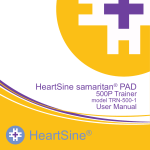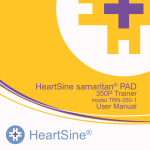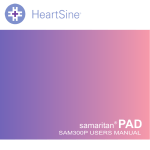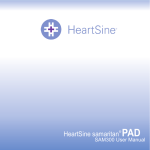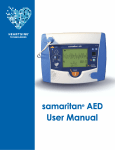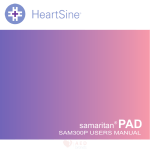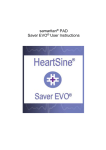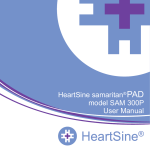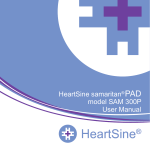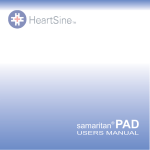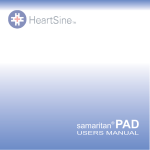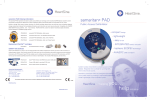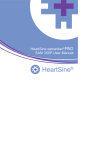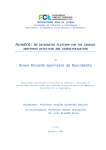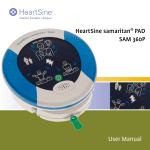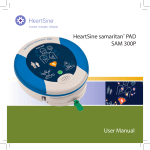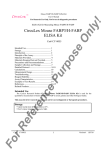Download samaritan® PAD User Manual
Transcript
samaritan® PAD User Manual Information in this document is subject to change without notice and does not represent a commitment on behalf of HeartSine Technologies Inc. No part of this manual may be reproduced or transmitted in any form or by any means, electrical or mechanical, including photocopying and recording for any purpose without the express written permission of HeartSine Technologies Inc. Copyright © 2004 HeartSine Technologies Inc All rights reserved. Printed in the United Kingdom “samaritan” is a registered trademark of HeartSine Technologies Inc. “Saver”, and “SCOPE” are trademarks of HeartSine Technologies Inc. All other trademarks and registered trademarks are the property of their respective owners. ® samaritan PAD August 2004 H017-001-010-0 HeartSine Technologies Inc (Worldwide Headquarters) 940 Calle Amanecer, Suite E San Clemente, CA 92673 Telephone: 1-949-218-0092 Fax: 1-949-218-0093 HeartSine Technologies, Ltd (European Operations) Canberra House 203 Airport Road West Belfast, BT3 9ED Northern Ireland Telephone: +44 28 9093 9400 Fax: +44 28 9093 9401 Website: www.HeartSine.com Email: [email protected] User Manual PAD Contents Introduction..............................................................5 1 Overview of this manual ...................................7 1.1 Conventions used in this manual .............................................................. 7 1.1.1 Notes and hints.............................................................................. 7 1.1.2 Warnings ....................................................................................... 8 1.1.3 References to other sources of information ................................. 8 1.1.4 Lists of instructions....................................................................... 8 1.1.5 Buttons .......................................................................................... 8 2 Warnings ............................................................9 3 Overview of the samaritan® PAD ..................11 3.1 Indications for Use ................................................................................. 11 3.2 The samaritan® PAD controls............................................................... 13 3.3 Samaritan® PAD symbols.................................................................... 15 4 Preparing the samaritan® PAD for use...........17 4.1 Quick List ................................................................................................17 4.2 Understanding the Pad-Pak™.................................................................17 4.2.1 Installing the Pad-Pak™ .............................................................18 ® 4.3 Ensuring the samaritan PAD is working correctly...............................19 ® 4.4 Where to place the samaritan PAD.......................................................19 4.4.1 Electromagnetic Interference Precaution ...................................19 4.4.2 Temperature and Humidity Constraints..................................... 20 5 Preparing the patient.......................................21 5.1 Patient Checklist...................................................................................... 21 5.2 Placing Pads on the Patient ..................................................................... 21 ” HeartSine Technologies Inc Version 1.0 Page 1 PAD User Manual 6 Using the samaritan® PAD ..............................23 6.1 Quick start................................................................................................23 6.2 Useful hints..............................................................................................24 6.3 Step-by-step instructions.........................................................................24 6.4 Understanding check patient mode.........................................................28 6.5 Post use procedures .................................................................................28 7 Understanding the samaritan® PAD...............29 ® 7.1 What is the samaritan PAD? ................................................................. 29 ® 7.2 What does the samaritan PAD do? ....................................................... 29 7.3 What is heart rhythm? ............................................................................. 30 ® 7.4 How does the samaritan PAD work?.................................................... 30 7.4.1 What is biphasic? ........................................................................ 31 7.4.2 Escalating energy protocol ......................................................... 32 7.4.3 Biphasic waveform specifications.............................................. 32 7.5 How is impedance measured?................................................................. 33 8 Understanding the samaritan® PAD interface35 8.1 Understanding visual indicators.............................................................. 35 8.1.1 Status Indicator ........................................................................... 35 8.1.2 Defibrillation Pads Connection Indicator .................................. 36 8.1.3 Shock Button Indicator ............................................................... 37 8.1.4 Rescue Action Indicators ........................................................... 37 8.2 Audible prompting...................................................................................38 8.2.1 Audible indications .....................................................................38 8.2.2 Voice prompting .........................................................................38 9 Recording the samaritan® PAD’s usage.........39 9.1 Recorded ECG information..................................................................... 39 9.2 Events log ................................................................................................ 39 Page 2 Version 1.0 ” HeartSine Technologies Inc User Manual PAD 9.3 Other information recorded..................................................................... 40 10 Maintaining the samaritan® PAD ...................41 10.1 Checking after each use........................................................................... 41 10.2 Monthly checks to perform .....................................................................42 10.3 Cleaning the device .................................................................................42 10.4 Storing the device .................................................................................... 43 10.5 Changing the language ............................................................................43 10.6 Battery specifications ..............................................................................43 11 Accessories for the samaritan® PAD ..........44 12 Troubleshooting.............................................45 13 Warranty and Repair ......................................47 Appendix ..............................................................48 ® i Samaritan PAD technical specification.................................................... 49 ii SCOPE™ Biphasic waveform specification............................................. 52 iii ECG analysis detection system description ...............................................54 iv ECG arrhythmia analysis algorithm performance ..................................... 55 v SCOPE™ Biphasic Clinical Summary ..................................................... 57 Glossary ........................................................................................................... 60 Index .. ........................................................................................................... 63 ” HeartSine Technologies Inc Version 1.0 Page 3 User Manual PAD Introduction ® This section introduces you to the samaritan PAD user manual. This manual ® explains how you use the samaritan PAD. PAD stands for Public Access ® Defibrillator. The samaritan PAD is a semi-automatic device used for the delivery of external defibrillation therapy to resuscitate victims of sudden cardiac arrest (SCA), who are unresponsive to stimulus, are not breathing, or ® have no detectable pulse. The samaritan PAD is designed for infrequent use. ® The samaritan PAD can also be used in conjunction with the Saver‰ data management system. Saver‰ data management software is used to configure ® and to review the use of the samaritan PAD. Information about Saver‰ data management software is provided in the separate Saver‰ user manual. @ Note: United States Federal Law restricts the use of this device by or on the order of a physician. Regulatory Requirements Defibrillator Tracking Requirements: The U.S. Federal Regulations (21 CFR 821) requires that manufacturers of defibrillators track the location of each defibrillator it manufactures. This regulation further requires that each purchaser or owner of a defibrillator notify the manufacture if the product is lost, stolen or destroyed. If the defibrillator changes ownership (either by donation, reselling or distribution) the manufacturer must be notified of the new location. Notification of Adverse Events Requirements: The Safe Medical Device Act requires that the defibrillator manufacturer and the FDA be notified of specific adverse events. These reporting events pertain to device related death, serious injury or illness. Who is required to report and what events are considered a reportable event can be found in the U.S. Federal Regulations, 21 CFR 803*. If you are unsure of what to do, always report any ® samaritan malfunctions or failures to HeartSine Technologies. @ * The requirement to report these events in the EU (incident reporting) and Canada (mandatory problem reporting) is covered in the medical device directive 93/42/EEC and the Canadian medical devices regulations. ” HeartSine Technologies Inc Version 1.0 Page 5 User Manual 1. PAD Overview of this manual ® This manual describes how you use the samaritan PAD. It helps you to understand the background to the device and provides instructions for performing tasks using the device. 1.1 Conventions used in this manual To draw your attention to certain items of importance in the manual and to help you understand instructions, this guide presents particularly important items in a stylised way. Conventions are used for the following: 1.1.1 • notes and hints • warnings • references to other sources of information • lists of instructions • buttons. Notes and hints Points worthy of note or that provide you with a hint are shown in italic lettering with a pencil symbol to bring them to your attention, for example: @ 1.1.2 ® The samaritan PAD will automatically disable energy charging and delivery for one minute at the end of any sequence of three automated deliveries to allow for CPR. Warnings Warnings are shown in bold lettering with a red triangle and exclamation mark to bring them to your attention, for example: ® To safeguard against interference, you must operate the samaritan PAD at least 2 meters (6 feet) away from all RF devices and other susceptible equipment. Alternatively, switch off the equipment affected by or causing the Electromagnetic Interference. ” HeartSine Technologies Inc Version 1.0 Page 7 PAD 1.1.3 User Manual References to other sources of information References to other sources of information are shown in sans serif lettering with a book symbol to bring them to your attention, for example: & 1.1.4 Refer to the Saver‰ online help for further information about configuring the ® samaritan PAD. Lists of instructions Instructions that you must follow in a sequential order are shown in a numbered list, for example: 1.1.5 1. Open the Pad-Pak™ and ensure that pads, cable and connector are undamaged. 2. Use the On/Off button to turn the samaritan PAD on or off. 3. Apply pads to patient’s bare chest. ® Buttons Device buttons are shown in bold sans serif lettering with initial capital letters, for example: • Page 8 Press the Shock button. Version 1.0 ” HeartSine Technologies Inc User Manual 2. PAD Warnings The samaritan® PAD has the capability to deliver therapeutic electrical shocks. The electrical shock can cause serious harm to either operators or bystanders. Caution must be taken to ensure that neither the operators or bystanders touch the patient when a shock is to be delivered. The samaritan® PAD has been designed to work on unconscious/nonresponding patients. Movement of the patient during analysis of heart rhythm can cause an error or delay in diagnosis. Care must be taken to minimise movement of the patient while analysis of their heart rhythm is being carried out. Touching the patient during the analysis phase of treatment can cause interference with the diagnostic process. Avoid physical contact with the patient until analysis and/or treatment has been completed unless the device instructs the operator to perform CPR. It has been determined that the samaritan® PAD is safe to use in conjunction with oxygen mask delivery systems. However, due to the danger of explosion it is strongly advised that the samaritan® PAD should not be used in the vicinity of explosive gases. This includes flammable anaesthetics or concentrated oxygen. Only be used on patients greater than 8 years old. ” HeartSine Technologies Inc Version 1.0 Page 9 PAD User Manual Proper placement of the samaritan® PAD pads is critical. Strict observance of pad positioning instructions, as indicated on the labelling and in training, is essential. Care must be taken to ensure pads are adhered to the patients’ skin properly. Air pockets between the adhesive pad and skin must be eliminated. Failure in pad adhesion may hinder effectiveness of therapy or cause excessive skin burns to the patient if a therapeutic shock is applied. Reddening of the skin may appear after use, this is normal. Periodic (as defined in manual) checks of this device must be undertaken to ensure among other things that the samaritan® PAD is not damaged in any way. The Pad-Pak™ is a single use item and must be replaced after the PadPak™ pouch seal has been broken or compromised in any way. If damage is suspected the Pad-Pak™ must be replaced immediately. This device is to be used by a person trained in the use of the product. Page 10 Version 1.0 ” HeartSine Technologies Inc User Manual 3. PAD Overview of the samaritan® PAD This section provides you with essential information that you can use to ® prepare yourself for using the samaritan PAD and as reference information for use while you use the device. This section contains chapters such as preparing the patient and provides instructions on how to use the device to deliver therapy. 3.1 Indications for Use: ® The HeartSine samaritan PAD is indicated for use on victims of cardiac arrest who are exhibiting the following signs: 1. Unconscious 2. Not Breathing 3. Without Circulation ® The samaritan PAD is intended for use by personnel who have been trained in its operation. Users should have received training in basic life support / AED, advanced life support or a physician-authorized emergency medical ® response training program. The samaritan PAD is not currently indicated for use on children less than 8 years old. ” HeartSine Technologies Inc Version 1.0 Page 11 User Manual 3.2 PAD The samaritan® PAD controls This section of the manual contains a brief description of each of the functions ® on the samaritan PAD. This section is a good starting point for new users of ® the samaritan PAD as it introduces each control on the device and explains their use. Figure 1 illustrates each of these controls. ® The controls available on the samaritan PAD are: 1. On/Off button – Use the On/Off button to turn the samaritan® PAD on or off. 2. Status Indicator – this indicator is a green icon that flashes approximately every five seconds when the device is operating correctly. When the Status Indicator isn’t flashing there is a problem with the device. 3. Speaker – the device provides audible prompts and information on the status of the device. 4. Pad-Pak™ – the patient pads and battery are contained in a tray on the underside of the device. The pads are attached to the device by a 1-meter cable. 5. Shock button – the Shock button can be pressed to deliver a shock when a shock is advised by the device. When a shock is advised, the Shock button is illuminated. 6. Electrode Connection Indicator – the electrode connection arrows are illuminated when the pads need to be applied to the patient or are not correctly attached. 7. Data Port – the Data Port is provided so that you can connect the samaritan® PAD to a PC computer and download therapy information. In order to download information, connect the samaritan® PAD to your computer using the data-recovery cable (SPD-303). Saver™ data management software for the samaritan® PAD must be installed on your PC in order to review the event data. ” HeartSine Technologies Inc Version 1.0 Page 13 PAD User Manual Data Port ® Figure 1 – The samaritan PAD Controls Page 14 Version 1.0 ” HeartSine Technologies Inc User Manual 3.3 PAD Samaritan® PAD symbols ® The samaritan PAD device and carry case use certain symbols to represent warnings. Depending on the type of danger apparent, different symbols are used. The table below provides an outline of the different symbols used: Symbol Meaning ® This symbol appears on the samaritan PAD and represents a general warning to take care. ® This symbol appears on the samaritan PAD and represents a warning against the danger of electric shock. ® This symbol appears on the samaritan PAD and represents a warning against the danger of explosion. ® This symbol appears on the samaritan PAD and represents a reference to the user manual. This symbol appears on the battery and is a warning not to recharge the battery. This symbol appears on the battery and is a warning not to short circuit the battery. This symbol appears on the battery and is a warning not to crush or puncture the battery. This symbol appears on the battery and is a warning not to overheat the battery. This symbol appears on the battery and is a warning not to incinerate the battery. ® This symbol appears on the samaritan PAD and indicates ® that the samaritan PAD uses a defibrillation protected Type BF patient connection. ” HeartSine Technologies Inc Version 1.0 Page 15 User Manual 4. PAD Preparing the samaritan PAD for use ® This chapter contains the following sub-sections: • Quick-list. • Understanding the Pad-Pak‰. • Ensuring the samaritan PAD is working correctly. • Where to place the samaritan PAD. ® ® ® It is imperative that the samaritan PAD is always prepared for operational use, since it is designed for use in emergency situations. This section provides you with information that will help you ensure that the device is always ready for emergency use. 4.1 Quick list ® Ensure that you follow this quick list to ensure that the samaritan PAD is always ready for use: 4.2 ® 1. Ensure that the samaritan PAD is clean and dry. 2. Insert a new Pad-Pak‰ into the samaritan PAD. 3. Check that the Status Indicator is flashing. 4. Position the samaritan PAD in a suitable and pre-arranged location. ® ® Understanding the Pad-Pak‰ ® The Pad-Pak‰ contains the power source for the samaritan PAD and the defibrillation pads. This combined package comes with one expiration date that encompasses the battery and defibrillation pads. ® The Pad-Pak‰ must be installed into the samaritan PAD by the install before date printed on the Pad-Pak™. There is a non-rechargeable integrated battery inside each Pad-Pak™, therefore, each Pad-Pak™ must be disposed of carefully after use. ” HeartSine Technologies Inc Version 1.0 Page 17 PAD 4.2.1 User Manual Installing the Pad-Pak‰ ® Before you begin to use the samaritan PAD, the Pad-Pak‰ must be fitted correctly. This is easily achieved as the tray can be inserted in only one direction. To insert the Pad-Pak‰, you: ® Slide the Pad-Pak‰ fully into the slot on the underside of the samaritan PAD until it clicks. Figure 2 –The Inserting the Pad-Pak‰ @ Page 18 Once the Pad-Pak‰ has been successfully inserted the Status Indicator flashes approximately every 5 seconds. Version 1.0 ” HeartSine Technologies Inc User Manual 4.3 PAD Ensuring the samaritan® PAD is working correctly ® The samaritan PAD automatically performs a weekly self-test to ensure that the device is working correctly. If the Status Indicator is not flashing the device is not working correctly. If the Status Indicator is not flashing a problem has been detected. You should refer to troubleshooting in this manual and/or contact HeartSine Technologies or your local HeartSine distributor for technical support. 4.4 Where to place the samaritan® PAD ® The samaritan PAD should be placed in an easily accessible location when in use. The Status Indicator must be clearly visible. ® The samaritan PAD must be stored with a Pad-Pak‰ installed. ® The samaritan PAD must not be used or stored in the presence of flammable agents or oxygen enriched atmospheres. 4.4.1 Electromagnetic Interference Precaution ® The samaritan PAD has successfully passed stringent electromagnetic interference tests. However, devices such as cellular phones and two-way ® radios may cause the samaritan PAD to operate erroneously due to radio ® frequency interference (RFI). The samaritan PAD may also adversely affect other susceptible equipment. ® To safeguard against interference, you must operate the samaritan PAD at least 2 meters (6 feet) away from all RF devices and other susceptible equipment. Alternatively, switch off the equipment affected by or causing the Electromagnetic Interference. ” HeartSine Technologies Inc Version 1.0 Page 19 PAD 1.1.2 User Manual Temperature and humidity constraints ® Successful operation and storage of the samaritan PAD is restricted by important environmental factors. Operating – during operation of the samaritan® PAD the temperature must be between 0 to 50˚C, with relative humidity (non-condensing) between 5% to 95% Storage & Transport – during storage of the samaritan® PAD temperature must be between -100 and 500 C, between 5% and 95% (non-condensation). Page 20 Version 1.0 ” HeartSine Technologies Inc User Manual 5. PAD Preparing the patient This chapter contains the following sub-sections: • Patient checklist. • Placing pads on the patient. It is imperative that the patient is fully prepared prior to the use of the ® samaritan PAD. This chapter provides you with instructions that you should follow to ensure that they are ready to receive therapy. 5.1 Patient checklist When preparing the patient for therapy you should use the checklist below to ensure that patient is correctly prepared. Important points to remember when preparing the patient are: 1. Dry the patient’s chest and remove excessive hair. 2. Ensure the disposable defibrillation pads are properly attached to the patient’s skin. 3. Ensure the patient is not in contact with metal objects. 4. Remove any non-defibrillator proof equipment attached to the patient. Delivering a shock to a patient that is not adequately prepared can have fatal consequences or may cause the therapy to be unsuccessful. 5.2 Placing pads on the patient It is essential that the disposable defibrillation pads are connected correctly to the patient. It is these pads that monitor the heart and deliver the therapeutic shock treatment. To connect the pads to the patient, you: 1. Pull out defibrillation pads pouch. 2. Open the pouch and remove the defibrillation pads. ” HeartSine Technologies Inc Version 1.0 Page 21 PAD User Manual 3. Peel pads one at a time from the protective backing, firmly place the pads sticky side down on the patient’s bare chest and ensure the pads are completely adhered to the skin. 4. Place one pad just below the right collarbone and place the other pad over the patient’s ribs in line with the armpit and below the left breast. See Figure 3 below. @ The correct placement of each pad is clearly illustrated on the PadPak™. The defibrillation pads must not touch each other. This can cause electrical arcing and possible skin burns, and may divert defibrillating energy away from the heart. Figure 3 – Where to place the pads Page 22 Version 1.0 ” HeartSine Technologies Inc User Manual 6. PAD Using the samaritan PAD ® This chapter contains the following sub-sections: • Quick Start • Useful Hints • Step-by-step Instructions • Understanding Check Patient Mode • Post use procedure This chapter provides you with all of the instructions that you need to use the ® samaritan PAD in an emergency. This section has been designed for quick reference in times of emergency but users should also read this section whenever they receive the equipment. 6.1 Quick start ® To use the samaritan PAD, you: & 1. Press the On/Off button 2. Pull out the defibrillation pads pouch. 3. Open the pouch and remove the defibrillation pads. 4. Peel pads from liner and apply pads to patient’s bare chest. Refer to section 5.2, Placing pads on the patient, of this manual for further details on placing the pads on the patient. 5. Follow audio guidance. 6. If directed, administer therapy by pressing the Shock button. ” HeartSine Technologies Inc Version 1.0 Page 23 PAD 6.2 User Manual Useful hints ® Don’t worry! – the samaritan PAD will provide audio prompts during the entire procedure. Good contact between the defibrillation pads and the patient is essential. 6.3 Step-by-step instructions 1. ® Press On/Off button to turn on samaritan PAD. ® The samaritan PAD is activated and you hear the audio prompt: “Call for medical assistance.” “Remove clothing from patient's chest to expose bare skin.” “Pull green tab to remove pads.” Figure 4 – Pull out defibrillation pads pouch Page 24 Version 1.0 ” HeartSine Technologies Inc User Manual PAD 2. Pull out defibrillation pads pouch. 3. Open the pouch, remove the defibrillation pads, peel pads from liner and apply pads to patient’s bare chest as illustrated. ® The samaritan PAD will continue with audio prompts: “Peel pads from Liner.” “Apply pads to patient’s bare chest as shown in picture.” “Press pads firmly to patient’s bare skin.” & Refer to section 5.2, Placing pads on the patient, for further details on placing the pads on the patient. @ The Pads Connection Indicator indicates if the pads are attached to the patient. If the pads are not attached to the patient, you will hear the audio prompts: “Check Pads.” ® If the pads are attached to the patient the samaritan PAD will begin to monitor the patient. 4. Assessing the patient When pads are attached to the patient you will hear the audio prompt: “Assessing heart Rhythm, Do not touch the patient.” ” HeartSine Technologies Inc Version 1.0 Page 25 PAD User Manual You must ensure the patient is kept still and that no one is in contact with the patient during analysis and therapy. Moving the patient can lead to incorrect or delayed diagnosis. 5. Administering a shock If a defibrillation shock is required on the first application to the patient, ® the samaritan PAD will prepare for shock delivery by automatically charging the energy delivery system. You will hear the audio prompts: “Analyzing, do not touch the patient.” “Stand clear of patient.” “Shock advised.” “Stand clear of patient.” Verbally and visually clear the patient. ® Once the samaritan PAD is charged, you will see the Shock button flashing and hear the audio prompts: “Press the Shock button now.” “Press the Shock button now.” Visually and verbally “CLEAR” the patient. Ensure no one is in contact with the patient. Then Press the Shock button to deliver the therapy. Do not touch the patient while defibrillation therapy is in process. Defibrillation energy can cause injury. The patient’s heart rhythm will automatically be analyzed to determine if the shock was successful. For safety precautions, if the Shock button is not pressed within 30 seconds after recommendation, the device will disarm and resume analyzing the patient’s heart rhythm. Page 26 Version 1.0 ” HeartSine Technologies Inc User Manual PAD Follow the audio instructions to repeat therapy if the initial shock was unsuccessful. @ & ® The samaritan PAD uses an escalating energy protocol to provide the shock. If the initial shock is unsuccessful the device will use the next highest energy level that has been specified in the configuration of the ® samaritan PAD to deliver another shock. It is possible to adjust this protocol using the HeartSine Saver™ software. Please refer to the Saver™ User Manual for instructions. Refer to Section 7.4.2 , Escalating energy protocol, for further information on this feature. Check Patient Mode After a successful shock or after three shocks have been delivered, the ® samaritan PAD will enter “Check Patient” Mode and you will here the following prompts: “It is safe to touch the patient.” “Check Airway.” “Check Breathing.” “Check for circulation.” “If needed begin CPR.” This mode lasts 60 seconds. During this period the patient should be reassessed by the rescuer. Check for signs of consciousness, breathing and circulation. If the patient is not breathing, CPR should be performed. ® Once the samaritan PAD has completed the “Check Patient” Mode, ® automated operation of the samaritan PAD will resume. If no shock is advised you will hear the following audio prompt: “No Shock Advised.” @ If no shock has been advised during any of the three automated shock ® delivery sequences, the samaritan PAD enters ‘Check Patient’ Mode. ” HeartSine Technologies Inc Version 1.0 Page 27 PAD 6.4 User Manual Understanding check patient mode ® The samaritan PAD enters “Check Patient” mode under the following circumstances: ® • if the samaritan PAD hasn’t delivered or advised a shock after a specific time period, determined by the diagnostic algorithm. ® • if the samaritan PAD has delivered three consecutive shocks. ® • if the samaritan PAD has charged twice and a shock hasn’t been delivered. ® If the samaritan PAD has entered “Check Patient” mode you hear the following audio prompts: “Check Airway.” “Check Breathing.” “Check for circulation.” “If needed begin CPR.” At this stage you can perform CPR on the patient if required. After 1 minute has elapsed you hear the audio prompt: “Stop CPR.” The device returns to Monitoring Mode. 6.5 Post Use Procedure Once therapy is completed, power off the device and replace Pad-Pak™. Page 28 ® 1. Press On/off button to turn samaritan PAD off. 2. Completely remove the Pad-Pak™ from the samaritan PAD and dispose of it safely. 3. Clean the samaritan PAD properly as described in the Cleaning and Maintenance section of this manual. 4. Insert a new Pad-Pak™ in the samaritan PAD. 5. Check the Status Indicator. 6. Position the samaritan PAD in a suitable and pre-arranged location. ® ® ® ® Version 1.0 ” HeartSine Technologies Inc User Manual 7. PAD Understanding the samaritan® PAD This chapter contains the following sub-sections: 7.1 ® • What is the samaritan PAD? • What does the samaritan PAD do? • What is heart rhythm? • How does the samaritan PAD work? • How is impedance measured? ® ® What is the samaritan® PAD? ® PAD stands for Public Access Defibrillator. The samaritan PAD is a semiautomatic device used for the delivery of external defibrillation therapy to resuscitate victims of sudden cardiac arrest (SCA), who are unresponsive to ® stimulus, are not breathing, or have no detectable pulse. The samaritan PAD is designed for infrequent use. ® The samaritan PAD should not be used on children under 8 years of age. 7.2 What does the samaritan® PAD do? ® The samaritan PAD provides the rapid application of defibrillation therapy, the only definitive treatment for potentially fatal heart arrhythmias. When the disposable defibrillation pads are properly applied to the patient’s chest and ® the samaritan PAD is used, the device: • monitors heart rhythm • advises whether or not therapy should be applied by providing audio instructions • delivers therapy using a carefully defined electrical shock, designed to stop the chaotic electrical activity experienced within the heart muscle during SCA, and return the heart to a normal rhythm. ” HeartSine Technologies Inc Version 1.0 Page 29 PAD 7.3 User Manual What is heart rhythm? The normal electrical rhythm by which the heart muscle contracts and expands to create blood flow around the body is known as Sinus Rhythm. When an individual suffers a sudden cardiac arrest (SCA), the heart may lose this rhythm and cease pumping. This results in a life-threatening but shockable rhythm - Ventricular Fibrillation (VF). An electrical shock can be administered to re-establish normal sinus rhythm. Shock therapy should be used only when appropriate. Therapy can result in injury or death to the patient if delivered when it is not required. ® The samaritan PAD embeds cardiac rhythm software. This software has been developed through many years of research into the accurate detection and identification of Ventricular Fibrillation and Ventricular Tachycardia. The device is therefore highly reliable in advising you when to deliver a shock. 7.4 How does the samaritan® PAD work? HeartSine and Academia have spent several years researching the analysis of heart rhythms to identify the optimal technique of applying the lowest possible amount of electrical energy, in order to resuscitate a victim of SCA. ® The samaritan PAD incorporates an advanced cardiac rhythm detection algorithm and the patented SCOPE‰ biphasic energy delivery system. This ensures a high degree of defibrillation efficacy and patient safety. ® The samaritan PAD works as follows: Page 30 1. The electrical rhythm of the heart is monitored via disposable defibrillation pads. 2. The samaritan PAD automatically analyzes the heart rhythm. 3. If the samaritan PAD decides the heart rhythm is one of a number of ® potentially fatal heart arrhythmias, the samaritan PAD delivery system is charged and the operator will be advised to shock the patient by pressing the flashing Shock button. 4. The samaritan PAD provides the operator with audio and visual prompts. These prompts: ® ® ® • instruct the operator on the next step when using the device • signal to the operator the current activity of the samaritan PAD ® Version 1.0 ” HeartSine Technologies Inc User Manual @ & 7.4.1 PAD • warn of any problems that have occurred • advise on safety requirements. All events during the monitoring and delivery of the defibrillation therapy are ® recorded and stored by the samaritan PAD and can be reviewed later using a PC. Refer to the Saver‰ software manual for further information on reviewing details of therapy. What is biphasic? A biphasic shock involves an electrical current being passed through the heart, initially in one direction, then in another, in order to restart the heart. Therapy must not only deliver energy but discharge it in a controlled and clinically effective manner. Extensive research and clinical trials have led to the recognition of the biphasic shock as the best definitive therapy for treating victims of cardiac arrest. A biphasic shock has been found to be as effective as higher energy monophasic shocks. ® HeartSine have developed the samaritan PAD using SCOPE‰ biphasic technology. The Self-Compensating Output Pulse Envelope Waveform is ® incorporated in the samaritan PAD, and delivers maximum effective therapy while minimizing any damage that could be caused by excess current. SCOPE‰ is able to do this by adjusting the biphasic energy waveform in terms of: • slope • amplitude • width. The above manipulation is based on a patient’s impedance and provides the most effective defibrillation for the specific patient. Performing Cardiopulmonary Resuscitation (CPR) on a patient connected to ® the samaritan PAD may interfere with accurate ECG monitoring. After CPR ® has been applied, you should periodically pause to allow the samaritan PAD to correctly analyze the patient’s ECG. ” HeartSine Technologies Inc Version 1.0 Page 31 PAD 7.4.2 User Manual Escalating energy protocol ® The samaritan PAD incorporates an escalating energy protocol. This is defined by: 1. An initial shock delivered at 100 Joules. 2. Heart rhythm analysis indicates if further therapy is advised. 3. A subsequent two shocks may be delivered at 150 and 200 Joules respectively. 4. CPR will be advised after three consecutive shocks have been delivered. 5. Heart rhythm analysis indicates if further therapy is advised. ® If further therapy is required, the samaritan PAD will continue at 200 Joules (following the set CPR protocol) until a non-shockable rhythm is restored. @ @ & @ 7.4.3 The escalating energy protocol has been configured by the factory. Changes of the escalating energy protocols should only be done on the direction of a physician. Refer to the Saver‰ user manual for details on changing the energy protocol. ® The samaritan PAD automatically disables energy charging and delivery for one minute at the end of any sequence of three shocks to allow for CPR. Biphasic waveform specifications ® The samaritan PAD generates therapy in the form of a Biphasic truncated exponential wave. The patient’s impedance is measured and this forms the ® basis of the Waveform parameters, which are adjusted by the samaritan PAD before therapy. ® The samaritan PAD charges the internal storage capacitors to a selected level. The output pulse phase is adjusted to ensure delivery of the selected level of energy. @ Page 32 Phase A and Phase B of the output pulse envelope are always of the same duration. Version 1.0 ” HeartSine Technologies Inc User Manual 7.5 PAD How is impedance measured? ® An impedance measurement is performed when the samaritan PAD is switched on. This measurement is important for the following reasons: • It checks the integrity of the electrode-patient contact and of the electrode leads. If the impedance is too high, electrode-patient contact is poor. If the impedance is too low, the pads may be touching each other. • It is used to adjust the Biphasic Waveform parameters to ensure optimum efficacy of the therapy. ® When the samaritan PAD is switched on: @ ® 1. The patient-pad impedance is measured and the samaritan PAD determines if the pads are correctly connected to the patient. 2. If a problem is found, the samaritan PAD will alert the operator and further use of the defibrillator will be disabled until the problem is corrected. ® Measurement of the impedance level is continuous. Therapy cannot be delivered if proper connection between the pads and patients is lost at any stage. The impedance value is used to determine some of the primary parameters of the waveform of the energy that is delivered, in order to customize the delivery pattern to the requirements of the individual patient. ” HeartSine Technologies Inc Version 1.0 Page 33 User Manual 8. PAD Understanding the samaritan PAD interface ® This section contains the following sub-sections: • Understanding visual indicators • Audible prompting ® The samaritan PAD provides audio and visual indicators that the operator must be able to see, hear and understand to use the device correctly. This chapter provides you with the information required to successfully ® understand and interpret the samaritan PAD interface. 8.1 Understanding visual indicators ® The samaritan PAD employs three different indicators in order to signal that something is wrong or to tell you the status of the device. These are, the: • Status Indicator • Defibrillation Pads Connection Indicator • Shock button Indicator • Rescuer Action Indicator This section provides you with information on understanding the messages conveyed by each of these indicators. 8.1.1 Status Indicator ® The Status Indicator is located on the face of the samaritan PAD. The Status ® Indicator verifies that the samaritan PAD is operating correctly. The Status Indicator can be interpreted in the following ways: • if the Status Indicator is flashing, the Pad-Pak™ is inserted correctly and ® samaritan PAD is operating correctly and ready for use. • if the Status Indicator is not flashing, the samaritan PAD is either still performing the self-test, or the self-test has detected one or more errors. ” HeartSine Technologies Inc ® Version 1.0 Page 35 PAD User Manual ® Do not use the samaritan PAD if the Status Indicator is not flashing. 8.1.2 Defibrillation Pads Connection Indicator The Defibrillation Pads Connection Indicator is a diagram illustrating a patient and defibrillation pads. If the arrows and defibrillation pads on this diagram are illuminated the defibrillation pads are not yet attached or are not attached correctly. If the defibrillation pads are attached then only the pads located on the patient’s torso in this diagram are illuminated. The Defibrillation Pads Connection Indicator is illustrated below: Illuminated Arrows and Pads Illuminated pads Figure 5 – Defibrillation Pads Connection Indicator Page 36 Version 1.0 ” HeartSine Technologies Inc User Manual 8.1.3 PAD Shock Button Indicator ® The Shock button Indicator illuminates. If illuminated, the samaritan PAD is fully charged and ready to deliver therapy once the Shock button is pressed. Be sure to verbally and visually clear the patient before pressing the shock button. Figure 6 – The Shock button 8.1.4 Rescuer Action Indicators The Rescuer Action Indicators are two diagrams located just below the shock button, illustrating a rescuer and a patient. The Rescuer Action Indicator is illustrated below: “Stand Clear,” when illuminated “It’s Ok to touch the patient,” when illuminated. Figure 7 – Rescuer Action Indicator ” HeartSine Technologies Inc Version 1.0 Page 37 PAD 8.2 User Manual Audible prompting ® The samaritan PAD employs two types of audible prompting: 8.2.1 • Audible indications, such as a short tone to indicate that the device has powered on • Voice prompting, such as instructions or warnings. Audible indications An audible indication is used to alert you when the device has been ® powered up. When the On/Off button is pressed, the samaritan PAD emits a short audible tone to indicate that power has been applied. 8.2.2 Voice prompting ® The samaritan PAD features a voice prompt to guide the user. Voice messages are used to provide the following types of information: Page 38 • Incorrect use • Progress • Instructions • Warnings Version 1.0 ” HeartSine Technologies Inc User Manual 9. PAD Recording the samaritan PAD’s usage ® This section contains the following sub-sections: Recorded ECG information Events log Other information recorded A sophisticated event recording system is automatically started each time the ® ® samaritan PAD is powered on. The samaritan PAD can hold all the information gathered during a session of therapy, without the need for retrieval. @ ® The samaritan PAD can record up to 45 minutes of ECG therapy. ® Each time the samaritan PAD is activated, a new session begins, and the data recorded during this session is retrievable via Saver‰. & Refer to the Saver‰ user manual for information on retrieving information saved ® by the samaritan PAD. The three types of information the Event Recording System records are, ECG information, events that occur during the therapy and other information such as date, time, and serial number. This chapter provides information on each of these different types of information. 9.1 Recorded ECG information ® The samaritan PAD is able to record the electrical activity of the heart (ECG) before, during and after therapy. @ 9.2 A clear indication of the heart’s activity is given. Transience and other adverse effects are suppressed. Events log ® The samaritan PAD recording system can record events that take place during the therapy session. The time and date is stored with each event. ” HeartSine Technologies Inc Version 1.0 Page 39 PAD User Manual The types of events that can be recorded are: 9.3 • buttons pressed • power up • monitoring • charging • therapy delivery • charge disarm • self-test • shut down • error codes – the error code associated with any error messages. Other information recorded ® Other information specific to the particular samaritan PAD and battery pack is recorded for reference. The types of specific information stored are: Page 40 • time • date • samaritan® PAD serial number • operating software revision number • number of charges/shocks per use Version 1.0 ” HeartSine Technologies Inc User Manual PAD 10. Maintaining the samaritan PAD ® This chapter contains the following sub-sections: • Checking after each use • Monthly checks to perform • Cleaning the device • Storing the device • Changing the language • Battery specifications ® It is imperative that you maintain the samaritan PAD correctly to ensure that ® you can rely on the device in times of an emergency. The samaritan PAD performs weekly self-checks to verify the readiness of the unit. ® Improper maintenance may damage the samaritan PAD or cause malfunction. The device must be maintained and cleaned as advised. ® To properly maintain the samaritan PAD, you must carry out regular checks: • after each use. • monthly. This section includes instructions for performing these checks and instructions for cleaning and storage. 10.1 Checking after each use ® The following procedure should be followed each time the samaritan PAD is used: 1. Dispose of the existing Pad-Pak™ 2. Use Saver‰ to download information about the therapy performed and erase memory. 3. Install a new Pad-Pak™ 4. Check the Status Indicator ” HeartSine Technologies Inc Version 1.0 Page 41 PAD User Manual If the Status Indicator is not flashing a problem has been detected. You should refer to troubleshooting in this manual and/or contact HeartSine Technologies or your local HeartSine distributor for technical support. 5. Check supplies, accessories and spares for damage or expiration and replace immediately if any damage or expiration is found. 6. Check the exterior of the samaritan PAD for cracks or other signs of damage and contact HeartSine Technologies if any damage is found. 7. Check the exterior of the samaritan PAD for dirt or contamination. Clean ® the samaritan PAD if dirt or contamination is found. & ® ® Refer to section 10.3, Cleaning the device, of this guide for information on how ® to clean the samaritan PAD. 10.2 Monthly Checks to perform The following checks should be performed monthly: Check supplies, accessories and spares for damage or expiration. Replace immediately if any damage or expiration is found. ® Check the exterior of the samaritan PAD for cracks or other signs of damage. Contact HeartSine Technologies if any damage is found. ® Check the exterior of the samaritan PAD for dirt or contamination. Clean the ® samaritan PAD if dirt or contamination is found. & Refer to section 10.3, Cleaning the device, on page 42 of this guide for ® information on how to clean the samaritan PAD. 10.3 Cleaning the device ® To clean the samaritan PAD, you: Page 42 • Wipe the samaritan® PAD with a soft cloth that has been dampened by one of the following: • Soapy water. • Isopropyl alcohol (70% solution). Version 1.0 ” HeartSine Technologies Inc User Manual PAD ® Do not immerse any part of the samaritan PAD in water or any type of fluid. Contact with fluids may seriously damage the device or cause fire or shock hazard. ® Do not clean the samaritan PAD with abrasive materials, cleaners or solvents. 10.4 Storing the device ® Important points to remember when storing the samaritan PAD are: ® Store the samaritan PAD in a suitable location for easy access. ® Store the samaritan PAD in a clean and dry environment. 10.5 Changing the language You can use Saver‰ to change the language in which the audible prompts are delivered. & Refer to the Saver‰ User Manual for further information on using Saver‰ to ® change the samaritan PAD language. 10.6 Battery specifications The battery lifetime can be up to 6 hours monitoring or 30 shocks or a combination of both. Unused batteries have a shelf life of 3 years. ” HeartSine Technologies Inc Version 1.0 Page 43 PAD User Manual 11. Accessories for the samaritan® PAD Part Number Unit ® samaritan PAD Defibrillator SAM 300 ® samaritan PAD ® samaritan Pad-Pak‰ Battery ® SPP-301 samaritan Pad-Pak‰ (includes battery & 1 set of pads, 8yrs - Adult) Carrying and Mounting Accessories SPS 301 Soft Carry Case SPS 302 Hard Carry Case SPS 303 Recessed Wall Cabinet with Alarm SPS 304 Wall Bracket SPS 305 Vehicle Bracket SSS 021 AED Wall Sign ® samaritan Data Storage and recall SDU 002 SAVER® Data Management & Review Software Licenses SPD 303 Additional Samaritan® PAD Data Recovery Cable Training Systems ® SPT-302 samartan PAD Trainer (with Trainer-Pak™ & charger) Additional Samaritan® PAD Trainer PAK (Includes Rechargeable battery and trainer pad) SPT-303 Replacement Samaritan® PAD Trainer defibrillation pads (Set of 3) STU-002 Replacement Samaritan® Trainer battery charger SPT-305 Page 44 Version 1.0 ” HeartSine Technologies Inc User Manual PAD 12. Troubleshooting ® This section provides some useful troubleshooting information for samaritan PAD: • Samaritan® PAD indicator is not flashing: • Check that a Pad-Pak™ is inserted into the Samaritan® PAD. • Check that the Pad-Pak™ is correctly inserted. When inserting the Pad-Pak™ you will hear a “click” once it is properly seated. • If the unit is properly powered, the Status Indicator flashes every 5 seconds. Contact [email protected] if you find that the device is still not working correctly. ” HeartSine Technologies Inc Version 1.0 Page 45 User Manual PAD 13. Warranty and Repair HeartSine Technologies will provide the following services under this warranty: • All faulty components which fail due to defective manufacture will be replaced free of charge for the following periods from the original date of purchase: • samaritan® PAD – 5 years • Pad-Pak™ – 3 years • HeartSine is responsible for extensions of the warranty period only when specifically agreed between HeartSine Technologies and the distributor. Please Note: HeartSine Technologies or the distributor are not obliged to carry out service under warranty if: • Unauthorized modifications have been made to the device. • Non-standard components are used. • The user has not used the device in accordance with the instructions provided in this manual. • The serial number of the apparatus is removed, defaced, misused or altered. • The device, pads or batteries are stored or used operationally outside of environmentally specified conditions listed within this manual. • Defibrillation pad packaging is not returned. • Any claims made under warranty must be directed via the distributor from whom the device was originally purchased. The distributor, before carrying out service under warranty, may require evidence of purchase. • The product must be used in accordance with the user manual and for the purpose that it was intended. If you have a query please contact [email protected] for assistance. ” HeartSine Technologies Inc Version 1.0 Page 47 PAD User Manual Appendix This chapter contains the following sub-sections: Page 48 ® • samaritan PAD technical specifications. • SCOPE™ Biphasic™ waveform specifications. • ECG analysis detection system description. • ECG arrhythmia analysis algorithm performance. • SCOPE™ Biphasic waveform Clinical Summary. Version 1.0 ” HeartSine Technologies Inc User Manual i. PAD Samaritan® PAD Technical specifications PHYSICAL Size: 8.0in x 7.25in x 1.9in (20mm x 18.4mm x 4.8mm) Weight: 1.1kg (2.4 lbs) including Pad-Pak™ Battery DEFIBRILLATOR Waveform: SCOPE® (self-compensating output pulse envelope) Biphasic Escalating waveform. Optimized biphasic waveform compensates energy, slope and envelope for patient impedance. Energy Selection: Pre-configured automated protocol (escalating from 100J, 150J, to 200J). Charge Time: 100J in less than 7 seconds and 200J in less than 12 seconds (200J) from a SA message with new Pad-Pak™. Shock Cycle Time: <60 seconds for three analyze/shock cycles. Controls: Shock, On/Off. PATIENT ANALYSIS SYSTEM Method: Evaluates patient’s ECG, signal quality, electrode contact integrity and patient impedance to determine if defibrillation is required. Sensitivity / Specificity: Meets AAMI DF 80 requirements. DISPLAY Visual Prompts: Attach Pads, Stand Clear, Perform CPR, Shock Now, Self tests Pass - Ready State. Indicators: Low battery voice prompt, (at least 10 discharges remaining), audible prompt (alerts user of electrode disconnect), service icon stops flashing if self-tests fail, no battery, or when service required Voice and icon prompts: Extensive voice and icon prompts guide the user through the operation sequence Languages: English ” HeartSine Technologies Inc Version 1.0 Page 49 PAD User Manual ENVIRONMENTAL Operating Temperature: 0˚to 50˚C (+32˚to +122˚F) Storage Temperature: -10˚to 50˚ Relative Humidity: 5% to 95% (non-condensing) Water Resistance: IEC 60529/EN 60529 IP44 Altitude: 0 to 15,000 feet (0 - 4,575 meters) Shock: MIL STD 810F Method 516.5, Procedure I (40G's) Vibration: • MIL STD 810F Method 514.5+ • Category 4 Truck Transportation - US Highways • Category 7 Aircraft - Jet 737 & General Aviation Exposure) EMC: EN 60601-1-2, Second Edition: 2001 Radiated Emissions: CISPR11: 1997 +1A:1999+A2:2001 Group 1 Class B Electrostatic Discharge Immunity: EN61000-4-2:1995 (8KV)+A1:1998+A2:2000 RF Immunity: EN61000-4-3:1996, 80 MHz - 2.5 GHz (10V/m)+A1:1998+A2:2000 Magnetic Field Immunity: EN61000-4-8:1993 (3 A/m)+A1:2000 Aircraft: RTCA / DO - 160D: 1997, Section 21 (Category M) Page 50 Version 1.0 ” HeartSine Technologies Inc User Manual PAD EVENT DOCUMENTATION Type: Internal memory Memory Capacity: 45 minutes of ECG (full disclosure) and event/incident recording. Playback Capabilities: Custom USB cable directly connected to PC and SAVER® windows-based data review software. Pad-Pak™ BATTERY PACK Pak Shelf Life: 3 years Weight: 0.44 lbs (0.2kg) Size: 3.93in x 5.24in x .94in (100mm x 133mm x 24mm) BATTERY Type: Lithium Manganese Dioxide (LiMnO2) 18V, 0.8 Amp Hrs Capacity: >30 shocks at 200J or 6 hours of continuous monitoring. Standby Life: 3 year ELECTRODES (pads) Electrodes: Samaritan® disposable defibrillation pads are supplied as standard with each device. Standard placement (anterior-lateral). Active Gel Area: 100 cm2 Cable Length: 3.5 ft (1m) Shelf Life: 3 years ” HeartSine Technologies Inc Version 1.0 Page 51 PAD ii. User Manual SCOPE™ Biphasic waveform specifications ® The HeartSine samaritan PAD delivers a Self Compensating Output Pulse Envelope (SCOPE) biphasic waveform. This waveform automatically optimizes the waveform pulse envelope (amplitude, slope and duration) for a wide range of patient impedances, from 20 ohms to 230 ohms. The delivered waveform to the patient is an optimized impedance compensated biphasic truncated exponential waveform that incorporates an escalating energy protocol of 100 J, 150 J, 200 J. The duration of each phase is automatically adjusted to compensate for varying patient impedances. The first phase (T1) duration is always equivalent to the second phase (T3) duration. The interphase pause is always a constant 0.4 msec for all patient impedances. The specific SCOPE waveform characteristics for a 100 J pulse are listed below. Page 52 Version 1.0 ” HeartSine Technologies Inc User Manual PAD Resistance (Ohms) Waveform Voltages (Volts) Waveform Duration (msec) V1 Tilt % T1 T3 25 1330 63.1 3 3 50 1380 44.1 3.5 3.5 75 1400 42.5 5 5 100 1410 39.3 6 6 125 1420 39.3 7.5 7.5 150 1420 37.6 8.5 8.5 175 1420 39.3 10.5 10.5 200 1420 37.9 11.5 11.5 225 1430 38.2 13 13 ” HeartSine Technologies Inc Version 1.0 Page 53 PAD iii. User Manual ECG analysis detection system description ® The HeartSine samaritan ECG Analysis Detection System has been designed to provide a Shock Advised decision for the following ECG Arrhythmias: • Ventricular Fibrillation – consisting of peak-to-peak amplitude of 200 uV. • Ventricular Tachycardia – consisting of a heart rate 180 BPM, and a QRS duration equivalent to > 0.14 seconds. ® The HeartSine Samaritan ECG Analysis Detection System has been designed to provide a No-Shock Advised decision for ECG Arrhythmias consisting of but not limited to: • • Normal Sinus Rhythm (NSR). • • Bradycardia. Supraventricular Tachycardia (SVT). Pulseless electrical activity (PEA). ® The HeartSine samaritan ECG Analysis Detection System analyzes 4 second segments of the patient’s ECG.! Should 2 contiguous segments of the patient’s ECG meet the shockable rhythm criteria, then the HeartSine ® Samaritan PAD shall provide a “SHOCK ADVISED” audible and visual prompt.! Should one segment of the patient’s ECG meet the non-shockable rhythm ® criteria, then the HeartSine samaritan PAD shall provide a! “NO-SHOCK ADVISED” audible and visual prompt. ® Even after a “SHOCK ADVISED” decision is rendered, the Samaritan ECG Analysis Detection System continuously assesses the patient’s ECG and if the patient’s heart rhythm spontaneously returns to a non-shockable rhythm, the ® samaritan PAD will automatically disarm and advise the operator.! Page 54 Version 1.0 ” HeartSine Technologies Inc User Manual iv. PAD ECG arrhythmia analysis algorithm performance ® The HeartSine samaritan ECG Arrhythmia Analysis Algorithm Performance has been extensively evaluated by using the American Heart Association’s (AHA) Database and the Massachusetts Institute of Technology MIT – NST ® database. The HeartSine samaritan ECG Arrhythmia Analysis Algorithm Sensitivity and Specificity meets the AAMI DF80a 2003 requirements and ® AHAb recommendations. The HeartSine samaritan ECG Arrhythmia Analysis Algorithm performance is summarized in the table. ” HeartSine Technologies Inc Version 1.0 Page 55 PAD User Manual Rhythm Class ECG c Test Sample Size Performance Specifications Performance 1,392 Sensitivity > 90% (VF) 95.75% 94.75% Sensitivity > 75% (VT) 100% 100* % Results 90% OneSided Lower Confidence Limit Shockable Rhythm: Ventricular Fibrillation (VF) and Ventricular Tachycardia (VT) Non-Shockable Rhythm: Normal Sinus Rhythm (NSR) 21,393 Specificity > 99% (NSR) 99.80% 99.76% 960 Specificity > 95% (NSR) 100% 100* % 11,826 Specificity > 95% (NSR) 99.74% 99.68% Non-Shockable Rhythm: Asystole Non-Shockable Rhythm: All other Rhythms * No error to measure a. Association for the Advancement of Medical Instrumentation. DF-80 – 2003 Standard for Medical electrical equipment – part 2 – 4; particular requirements for the safety of cardiac defibrillators (including automated external defibillators). b. Automatic External Defibrillators for Public Access Defibrillation: Recommendations for Specifying and Reporting Arrhythmia Analysis Algorithm Performance, Incorporating New Waveforms, and Enhancing Safety and Efficacy. AHA Task Force on Automatic External Defibrillation, Subcommittee on AED Safety and Efficacy. Circulation, 1997, Vol. 95, 1677-1682. c. AHA and MIT-NST databases Page 56 Version 1.0 ” HeartSine Technologies Inc User Manual v. PAD SCOPETM Biphasic Waveform Clinical Summary The HeartSine SCOPE Biphasic waveform has been clinically tested in a three phase validation program. Numerous animal studies have been conducted to compare the efficacy of the SCOPE biphasic to other defibrillation waveforms. Results of these studies have been published. “Optimization of transthoracic ventricular defibrillation-biphasic and triphasic shocks, waveform rounding and synchronized shock delivery.” Kidwai BJ, McIntyre A, Anderson J, Adgey AAJ. Journal of Electrocardiology, Vol. 35, No. 3, 2002. In addition, a Human Clinical Trial has been conducted comparing the SCOPE biphasic waveform to a currently marketed, constant energy, biphasic defibrillator (Biphasic “X”). Results from this study are submitted below. PURPOSE: To establish the efficacy of conversion of VF/VT at low energies with a new ® biphasic waveform by demonstrating that the HeartSine samaritan SCOPE is at least equivalent to another clinically marketed, constant energy, biphasic system (Biphasic “X”). METHODS: Standard disposable defibrillator pads were used by both devices. The shock protocol used by the arrest team followed the hospital standard of care - 150J ® shocks for the 1st 2nd and 3rd shocks on each VF/VT episode. The samaritan st was used to deliver a 1 shock energy of 100J followed by 150J and then 200J for the 2nd and 3rd shocks respectively. Any shocks delivered after these first three shocks were at the discretion of the attending physician for either device. CPR proceeded as per UK Resuscitation Council Guidelines. ” HeartSine Technologies Inc Version 1.0 Page 57 PAD User Manual DATA COLLECTION: The two devices to be compared were utilized on alternate days. The responding team arrived at each arrest with the defibrillator appropriate to the day of attendance. Inclusion : Known or suspected cardiac arrest patients. Exclusion : Any patient who has already received a thoracic shock therapy prior to the resuscitation team. Patients < 36Kg. Patients with do-not-resuscitate (DNR) instructions. Patients whose cardiac arrest has obviously resulted from a non-cardiac cause (trauma, drowning etc.) ANALYSIS: Each record was interpreted by a qualified cardiologist and annotated to detail each VF/VT episode and determine the success or failure of a device to terminate the arrhythmia. Successful defibrillation was defined as termination of VF for > 5 seconds, or termination of other "shockable" Ventricular Tachyarrhythmia for > 5 seconds. Any subsequent recurrence was defined as a new episode. Page 58 Version 1.0 ” HeartSine Technologies Inc User Manual PAD RESULTS: Total number of patients ® : HeartSine samaritan = 8 Biphasic “X” = 23 VF Summary Total number of successful shocks HeartSine samaritan® % 28.0 100.0 28.0 66.7 Biphasic “X” % 62.0 100.0 61.0 39.4 Total number of unsuccessful shocks 14.0 33.3 94.0 60.6 Success within 1 shock 18.0 64.3 24.0 85.7 28.0 100.0 36.0 43.0 48.0 58.1 69.4 77.4 Parameter Total number of episodes Success within 2 shocks Success within 3 shocks Average number of 1.5 shocks required Average energy required (J) Average energy reduction (J) 125.0 25.0 16.6 2.5 150.0 SUMMARY The initial results from the Human Clinical trial shows that the HeartSine SCOPE biphasic waveform is at least as effective as the other marketed, constant energy biphasic waveform system. ” HeartSine Technologies Inc Version 1.0 Page 59 PAD User Manual Glossary Pad-Pak™ ® The Pad-Pak™ is a tray that fits into the samaritan PAD. This pack contains the defibrillation pads that you must connect to the patient’s chest and the ® battery that supplies power to the samaritan PAD. You open this tray to access the defibrillation pads. Biphasic Shock A biphasic shock is an electrical current that is passed through the heart, firstly in one direction and then in another. Defibrillation Electrodes Defibrillation Electrodes are pads that are connected to the patient’s chest in order to administer therapy. Electromagnetic Interference Electromagnetic interference is radio interference that may cause erroneous ® operation of the samaritan PAD. Impedance Measurement Impedance measurement is a check that is performed to check the integrity of pad-patient contact. PAD The PAD is a semi-automatic device used for the delivery of external defibrillation therapy to resuscitate victims of sudden cardiac arrest (SCA), who are unresponsive to stimulus, are not breathing, or have no detectable pulse. Saver‰ ® Saver‰ is software that can be used in conjunction with the samaritan PAD ® to retrieve and view information about therapy delivered using the samaritan ® PAD and to configure the samaritan PAD so that it you can tailor the device to suit your requirements. Page 60 Version 1.0 ” HeartSine Technologies Inc User Manual PAD SCOPE‰ SCOPE‰ stands for Self-Compensating Output Pulse Envelope Waveform. This is the biphasic technology developed by HeartSine that is incorporated ® into the samaritan PAD. Sinus Rhythm Sinus Rhythm is the normal electrical rhythm by which the heart muscle contracts and expands to create blood flow around the body. Self-test ® A Self-test is a semi-automatic test that is used to check that the samaritan PAD is working correctly. Ventricular Fibrillation Ventricular Fibrillation is a life-threatening heart rhythm that is treatable with ® the therapy using the samaritan PAD. ” HeartSine Technologies Inc Version 1.0 Page 61 User Manual PAD Index Audio .................................................. 38 Preparing the samaritan PAD........... 15 Battery Specifications ........................ 51 Quick List ........................................... 15 Biphasic .............................................. 57 Quick start .......................................... 21 Constraints Pad-Pak™ ® Temperature & Humidity............... 50 Installing......................................... 16 Electromagnetic Interference............. 19 Understanding ................................ 15 Glossary .............................................. 60 Recording usage ................................. 39 Heart rhythm....................................... 30 ECG trace ....................................... 39 Hints.................................................... 24 Events ............................................. 39 Impedance........................................... 33 Information recorded ..................... 40 Language ............................................ 43 Repair.................................................. 47 Maintenance ....................................... 41 Self-test............................................... 17 PAD Step-by-step instructions.................... 22 Battery Specifications .................... 44 Support.......................................... 45, 47 How does it work? ......................... 30 Symbols .............................................. 13 Language ........................................ 44 Maintenance ................................... 41 Storing ............................................ 43 Understanding ................................ 29 What does it do?............................. 29 What is it?....................................... 29 Where to place................................ 17 Patient ® The samaritan PAD Interface .......... 35 Troubleshooting ................................. 45 ® Using the samaritan PAD ................ 21 Visual indicators................................. 35 Volume ............................................... 37 Warning ........................................ 13, 45 Warranty ............................................. 49 Waveform specifications ................... 55 Checklist......................................... 19 Electrodes (pads)...................... 19, 33 Preparing......................................... 19 ” HeartSine Technologies Inc Version 1.0 Page 63 Worldwide Headquarters: Heartsine Technologies, Inc. 940 Calle Amanecer, Suite E San Clemente, CA 92673 Tel: 1.949.218.0092 Fax: 1.949.218.0093 Manufactured by: HeartSine Technologies, Ltd. Canberra House 203 Airport Road West Belfast, BT3 9ED Northern Ireland Tel: +44 (0)28 9093 9400 Fax: +44 (0)28 9093 9401 [email protected] www.heartsine.com H017-001-010-0



























































